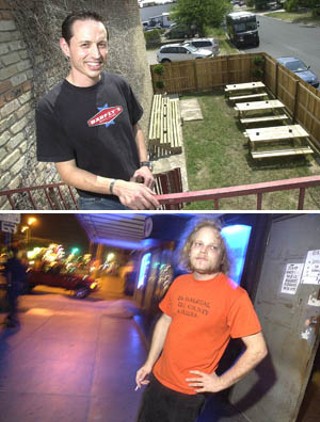911, We've Got a Smoker
Austin's new smoking ordinance
By Darcie Stevens, Fri., Sept. 2, 2005

Would you believe that local club owners, bartenders, and doormen have been instructed to call 911 when encountering a smoker in their establishment? Well, they were. Two weeks later, said enforcement of Austin's new Smoking in Public Places Ordinance – which can be read in its entirety at www.keepaustinfree.com and is available at the city of Austin's Health and Human Services Web site, www.ci.austin.tx.us/health – was downgraded to "following your standard business practices for enforcing house rules." Unfortunately, standardization doesn't typically exist in the bar business. While a simple "no smoking" sign should ultimately do the trick, interpreting SIPPO isn't quite so easy.
The seven pages of ordinance are rife with legalese and nods to fraternal organizations and nursing homes, but what our club and bar owners are concerned with is the skeleton of the law: what the rules are ("Smoking Prohibited"), what the exceptions to the rules are ("Exceptions"), and what happens if the rules are broken ("Enforcement"). It's your basic grade-school guidelines, written as if by and for grade-school students.
Phrases like "necessary steps," "due diligence," and "selective enforcement" come up more times than anyone is comfortable with, which is the end result of a standardized ordinance drafted by a national special-interest group – Americans for Nonsmokers' Rights – not by Austin residents, and without legal oversight (www.no-smoke.org/document.php?id=229). The intentions of Austin's SIPPO might be well and good, but questions overflow like cigarette butts in the gutters whenever the topic of enforcement comes up.
Austin's smoking ban is instituted today, Thursday, Sept. 1, and what the future holds remains hazy at best. The biggest fears are still closure, license revocation, and loss of wages, but now, add confusion to the top of that list. Austin bar and venue owners are more than willing to comply with the law. The question is how.
Section 10-6-2: Smoking Prohibited
The ordained smoking ban comprises five definitions of a smoking offense. The first four begin, "A person commits an offense," which defines when a smoker is breaking the rules: smoking in a public place, in an enclosed area owned by the city, in an enclosed area of a workplace, or within 15 feet of any entrance. The last definition reads, "The owner or operator of a public place commits an offense if the person fails to take necessary steps to prevent or stop another person from smoking in an enclosed area in a public place."
In English? A business owner takes the fall for all indiscretions. A smoker will never be cited. The catch here is the term "necessary steps." What does that mean? Austin's Health Department has chiseled that phrase down into five parts: Post no-smoking signs in all doors and windows, remove ashtrays, ask patrons to stop smoking, ask patrons to leave the premises if they refuse to stop smoking, and the infamous "follow standard business practices for enforcing house rules."
Again, simple, right? Try reading between the lines. Business owners are the enforcers, expected to run off their clientele, possibly endangering themselves, and depending on what standard practices they subscribe to – did everyone get that Running a Bar 101 manual? – defend themselves. It's a lot of enforcing for an untrained community to accept. In addition, only those employers who attended one of the Health Department's four August community meetings have been given these guidelines.
"I'm not going to get in fistfights with my customers over whether they're smoking or not," Lovejoy's owner Chip Tait half jests. "I hoped, walking into that meeting, that they'd say, 'Okay, guys, here's the deal. On the first, no tolerance. We're going to post armed guards at every door. It's going to be three months of hell, and then we're all going to get used to it.' But it doesn't seem to be working out that way."
Back Room general manager Sean McCarthy concurs. "I'm not going to get unruly with people," he says. "They have the option of either stepping outside into our new beer garden or leaving."
Broken Spoke manager Jenny White, daughter of James, thinks of it along the lines of the current TABC rules.
"We don't have any trouble telling anyone they can't have anything else to drink," she equates. "We don't expect any trouble like that, but we just don't know how this will affect us."
"We were told that we're guaranteed police protection under the Constitution," relates Beerland owner and major Keep Austin Free player Randall Stockton. "Therefore we have at our disposal this option to dial 911, and in fact, it's the final and ultimate necessary step in order to cover our butts."
That's what everyone is concerned with: butt covering. Like his fellow bar owners, Saxon Pub owner Joe Ables is trying to remain positive.
"We lost, the smokers lost, but we think that smokers are still going to come out. I don't think they're going to stay home and smoke. It's just one of those things. I used to smoke, and I remember the first time I couldn't smoke in an elevator, and I got used to it. I remember the first time I couldn't smoke in a building, and I got used to it. It's just a shrinking smoking world."
Section 10-6-3: Exceptions
While SIPPO's excepting of hotel rooms, retail tobacco stores, nursing homes, and bingo parlors didn't exactly seem fair to business owners not catering to the rich and elderly, there's one little clause in the ordinance comparable to making lemonade when given lemons. When in doubt, build a patio.
In addition, while most venues define their age restrictions by TABC rules and regulations, the outgoing ordinance provided that no one under 18 be admitted into a venue where smoking was permitted. The new ordinance says nothing about age restrictions, therefore, in theory, all bars and venues could become all ages if it weren't for those blasted TABC restrictions. All of Austin's current facilities except eight have that option. And what of the other eight? Well, IHOP, Trudy's North and South, Bennigan's, Cool River Cafe, Hooters, Shoal Creek Saloon, and Iron Cactus all have been issued restricted permits under Section 10-6-3(8): "This chapter does not apply to a business premise that was issued a restricted permit by the city on or before November 2, 2004." Those eight lucky establishments can permit smoking until 2012, but they can't allow entry to patrons under the age of 18. You just can't have your cigarettes and smoke them, too.
"I've got no choice," states Ables. "We're going to make it work. The smokers here know that we tried, and I have a big smoking crowd. I was vocal in it, but that's over. I understand there's still some movement to try to continue to fight it, but I don't see any hope in that."
Ables isn't only complying with SIPPO by constructing a huge patio complete with a closed-circuit feed of stage shows. In fact, rumor has it that a Saxon Pub spin-off, a full-fledged icehouse down the street, is in the works and that a kitchen is being planned into the current bar's construction. When the smoke clears, there's room for food. For his part, the Broken Spoke's James White is planning on selling his ashtrays as souvenirs of the good old days.
Marcos Canchola, owner of both Airport Boulevard bar Barfly's and downtown's Mugshots, is in the fortunate position of being able to add outdoor seating to both his establishments.
"Barfly's is a smoky bar," he admits freely. "I'm definitely skeptical about [the ordinance]. I think that my clientele is going to suffer, but then again on the same hand, maybe some people who don't come out will."
Canchola and Ables aren't alone. Horseshoe Lounge owner Tennia Brown is putting up tents, Stockton plans on adding sidewalk cafe seating under the Beerland awning, and McCarthy just finished his Back Room beer garden.
"I just don't want to make a leper colony out of it," McCarthy says. "I've got big-screen TVs out there, and I'm putting live music out there for happy hour for free. We're actually going to make this work to our advantage this time."
For those fortunate venues that already have patio areas – Flamingo Cantina, Emo's, Red Eyed Fly, and the Longbranch Inn, among others – the only thing to worry about is measuring 15 feet out from the door. As long as a smoker is past that magic mark, the owner is in the clear.
But not everyone is expelling sighs of relief.

"Obviously, [the patio's] a benefit," Flamingo Cantina owner Angela Gillen acknowledges. "However, I'm not sure that's going to solve the problem. I don't feel it's right that we've become the enforcers, either, because ultimately, we are responsible."
"I think it will really affect some people that didn't have any options like we had," Longbranch owner Jim Stockbauer worries. "We just got lucky that we have that [unenclosed area] on the side, but for some people that are locked in, it could be tough."
Room 710 employee Joe Sebastian knows what's it's like being locked in. The Red River venue doesn't really have patio options, but they remain hopeful.
"What will hurt is regular bar business," Sebastian opines. "If smokers want to see a band, they can go for an hour and not smoke, or they can run outside and have a smoke break. But if they want to go out all night and hang out, and every time they want to light up they're going to have to walk out into the street, then there will probably be a lot of people who are going to stay at home in their back yard and buy a six pack."
Like 710 and the Broken Spoke, whose employees feel lucky just having a parking lot, Deep Eddy Cabaret is facing their future without a patio and with a truckload of uneasiness.
"We're known as the smokiest bar in town by a lot of circles," Deep Eddy manager J.T. Travis admits. "I don't know that that's true, but we're certainly not not smoky. And there are a lot of people that probably don't come here because of that, but that's part of our deal."
Up until now. When the fight began back in the spring ("Smoke Signals," Music, April 15, 2005), music venues were shaking in their boots over the loss in revenue SIPPO-like measures have already visited on other major cities. Now, with school back in session and after many sleepless nights, those same club owners have made peace with their eggs being in the baskets of Austin's hardcore music lovers. Bar owners who don't have regular live music are understandably less confident.
"What city do we want to be?" asks the Horseshoe's Brown. "Do we want to be Austin, Texas? Do we want to be Dallas? Do we want to be Los Angeles? I think we're a combination of all three. Austin is losing its character.
"I'm just going to keep my fingers crossed and pray."
Section 10-6-10: Enforcement
"The intent is not to be punitive," emphasizes Shannon Jones, assistant director of public health for Austin/Travis County Health & Human Services. "We're not out to get club owners. I don't think the ordinance was out to get club owners. Our goal is to enforce what's there. We will do it in a cooperative manner. We plan to work with vendors and help them understand what the law is."
Lord knows vendors are going to need help. Enforcement of SIPPO is like a Shakespearian sonnet: It looks simple at first, but when you start digging, it's just a mess of words and intentions. While business owners are expected to do the bulk of the enforcement, dealing with extreme cases hasn't yet been fleshed out.
"We're going to enforce it to the best of our ability," Jones relates. "Which means we recognize that when we're not there, there might be some violations that are occurring."
When will the Health Department be present? Only when called upon for the most part. Austin's SIPPO is completely complaint-driven. Every citizen has the option of calling the Environmental and Consumer Health Unit (972-5600) when they observe a smoking violation. Only the name of the establishment, correct address, date, time, and description of the violation are needed to file a complaint. Whether those items are accurate or not will be impossible to judge.
Regardless, at that point, a health inspector will be dispatched within 24 to 72 hours after the complaint is made. That, my dear, is a very long cigarette. This reaffirms the Health Department's stance that their office won't be hunting down smoking rebels. Their main objective is educating the public and industry and enforcing the ordinance with "due diligence," which means they'll do what they can. If violations are recorded upon an inspector's arrival, a citation can be issued, an explanation and warning might be all that's needed, or, worst-case scenario, a liquor license can be revoked.
It's important to note that the Health Department has only two inspectors dealing exclusively with smoking complaints, as well as six food inspectors who can double as "smoking police." Along with the ambiguities of the ordinance, a little matter of funding was left out. What about the person doing the dastardly deed?
"Our department does not plan to get in the business of citing smokers," Jones replies. The Health Department repeats that time and again: A smoker will never be cited.
"Whoa, whoa, whoa! By God! What does the ordinance say?" asks Austin Police Association president Detective Mike Sheffield in disbelief. "I will tell you this: If an officer gets there and there's a city ordinance saying you can't smoke, the offense is occurring in his presence, and that person fails to respond and says, 'No, I'm gonna sit here and smoke my cigarette,' what choice does that officer have?"
This isn't an example of interdepartmental lack of communication. Well, it might be. Mostly, it's an example of the lack of instruction in the ordinance. While defining four offenses by the smoker, SIPPO fails to account for individual smoker punishment. Thus, each government entity is basically forced to write its own rules. Enter the term "selective enforcement."
The difference between a warning, citation, and license revocation is enormous, and it all seems to hang on a particular inspector's or officer's demeanor, knowledge of the law, and, well, mood that day. The fact that the ordinance is complaint-driven is scary enough to those bars that were heavily publicized in the first round of the battle. Talk of complaint vigilantes and Onward Austin posses isn't unheard of. Hopefully none of that will happen, but the possibility for frivolous complaints is written as law.
Section 10-6-12: Public Education
How did a poorly written form letter of legislation become law?
"Outsiders wrote this law, and some well-intentioned Austin voters were duped," shrugs Beerland's Stockton. "The thing that's most troubling is that the city is now strapped with this unenforceable, unfunded, perhaps unconstitutional ordinance."
No matter how hard the Health Department tries to educate the populous, enforcement remains a gray, ashen area. Thus, most of the city's bar owners and venue operators aren't sure what to expect. There's still talk of legal battles in the future and even mention of an "initiative" to get the nonsmokers to come out; "Live and Kickin'" includes a cleaning service, bus tours, and freshly squeezed juice with a benefit scheduled at Threadgill's World HQ on Sunday, Sept. 4, to support the efforts. At least they're trying.
Ultimately, this is just one more notch on the bedpost. Along with strict TABC rules, noise ordinance restrictions – which became a big problem in New York City upon their smoking ban's implementation thanks to sidewalk chatter – and extreme taxation, now bar owners need to invest in a pair of night-vision binoculars and a megaphone. Those smokers can be tricky.
Obviously, everyone hopes that the state of Austin nightlife will remain vibrant. We're all aware that, for the most part, Austinites are respectful and polite. The appearance of an unruly smoker will more than likely remain rare, and the city's Health Department is definitely not the enemy.
Nevertheless, reports coming out of New York and California claiming a 30% drop in revenue in the first six months of a smoking ban are frightening to say the least. Add the fact that the Austin City Council can't touch the ordinance for two years, and that a judge is unlikely to repeal a law that was implemented as a "repeal and replace" ordinance. If SIPPO is overturned there is no smoking law at all. At this point in time, like the Horseshoe Lounge's Tennia Brown says, all we can do is cross our fingers. In the meantime, keep on going out, and please, tip your bartenders.








